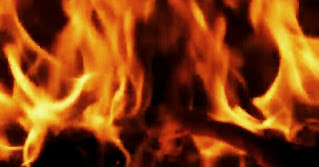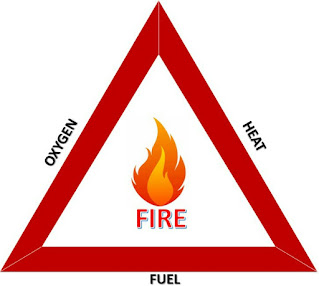INTRODUCTION
The knowledge about the ‘Methods to produce Fire’ is regarded as one of the greatest discoveries of all time. Fire is regarded as one of the primary components which is required to lead a normal life. In olden days, there were no greater scientific advancements and people used to lit the fire outside their living places on a plane habitat with the help of wood or dried leaves etc. They used fire to cook the food (especially meat) and to light up their surroundings at night. They used sand and water to extinguish the fire which they have ignited. But in this era, the scientific advancements have led to manufacturing of several new products which are ‘flammable’ and few products can be found in our home too. According to the source of fire, the fire hazards are classified into 6 types. All these types of fire cannot be extinguished by water alone and sometimes using water can increase the strength of fire and make it even dangerous.
 |
| Fire - Greatest discovery made by mankind |
THE FIRE TRIANGLE
The Fire triangle is the commonly used model to understand the parameters which are required for combustion to take place. Combustion is a scientific term which is used instead of burning. Normally during combustion, the oxidation reaction is accompanied. For example, the Carbon source in the fuel gets converted into Carbon dioxide (in case of perfect combustion with essential amount of Oxygen supply).
From the fire triangle, we can infer that the important parameters required for combustion are Fuel, Oxygen and Temperature. The Fuel is any substance which is the raw material for burning. Fuels are not limited to petrol, diesel and other hydrocarbon fuels. Fuels also include paper, wood, dried leaves etc., which can burn when fire is kindled. Temperature is also required primarily as it is the component which ignites the fuel to burn. Also, continuous supply of oxygen is required for effective combustion. The effect of oxygen can be well described by the normal ‘Candle Experiment’ where the candle’s flame gets extinguished when the oxygen supply from air is cut off using an inverted jar/vessel. So, to extinguish the fire, one of the three parameters has to be cut off to break the fire triangle.
FIRE CLASSIFICATION
As mentioned earlier, fire can be classified into 6 types on the basis of Fuel. They are
- Class A fire (Solid fuel)
- Class B fire (Liquid fuel)
- Class C fire (Gaseous fuel)
- Class D fire (Chemical source)
- Class E fire (Electricity source)
- Class F or Class K fire (Kitchen source).
CLASS A FIRE
If the fire is started with solid materials like wood, papers, dries leaves, plastic, solid wastes etc. as fuel, then it is termed as Class A fire. Class A fire can be extinguished by using water. Sand can be used too along with water extinguisher. But Class A fire can lead to several other disasters like burning of electricity cables, circuits etc. which can maximize the threat and water should not be used in this case. Carbon dioxide extinguishers can be used in this case.
Safety measures
- Don’t pile up the solid waste and try to dispose them as soon as possible.
- Smoking can also act as a threat. So, smoking should be prohibited within industry.
- Extinguishers, Water hoses etc. must be placed at the perfect place.
- Workers and communities should be trained to use the extinguishers properly.
CLASS B FIRE
If the fire is started by Liquid fuels, then it is termed as Class B fire. This type of fire can be more dangerous to the environment and causes severe threat to property and human life. Flammable liquids, Cleansing solvents (which has alcohol content in it) etc. are some of the examples. Water cannot be used as an extinguisher here and it only makes the situation dangerous. Since the fuel is liquid, there is a greater chance for spread of fire. This type of fire can be extinguished with Foam type extinguishers.
Safety measures
- Storage and transportation of flammable liquids have to done with extreme care.
- Workers should be well educated to know the different sources of fire and its extinguishing methods and to use it properly
CLASS C FIRE
If the fire is caused due to ignition of Gaseous fuels, then it is called as Class C fire. This is the most dangerous form of fire, as gas is hard to control. Here, the gaseous fuels may be methane, natural gas etc. and it happens rarely at refineries and industries. This type of fire can be extinguished with ABC dry powder fire extinguishers.
Safety measures
- The first and foremost thing to do in this type of fire hazard is to Shut down the gas supply.
- Workers should be well educated to know the different sources of fire and its extinguishing methods and to use it properly
- The parameters related with gas storage and usage should be monitored properly.
CLASS D FIRE
If the fire is due to the ignition of metals, it is termed as Class D fire. The Class D fire normally occurs where the temperature is extremely high. In case of Class D fire, water cannot be used as the enormous heat results in splitting of water molecules into Hydrogen and oxygen molecules, where oxygen accelerates the combustion process. This type of fire can be extinguished by extinguishers that contain Sodium chloride blended dry powders which forms a layer over the metal thus cuts off the supply of Oxygen to the fuel (metal).
Safety measures
- Workers should be well educated to know the different sources of fire and its extinguishing methods and to use it properly.
CLASS E FIRE
If the fire is due to electrical sources, it is termed as Class E fire. Here, we should understand that Electricity is not a fuel. Thus, fire caused due to electrical components are mostly not classified under fire types. Yet we should be aware of its extinguishing methods. Water cannot be used here as electricity splits water to oxygen and hydrogen atoms (Electrolysis process) where oxygen accelerates the combustion process. Normal dry powder extinguishers are suitable to put off these fires.
Safety measures
- The first and foremost thing to do in this type of fire hazard is to Shut down the electricity supply.
- Workers should be well educated to know the different sources of fire and its extinguishing methods and to use it properly
CLASS K or CLASS F FIRE
Class K or Class F fire is the fire which is caused due to the combustion of household fuel components like cooking oil, animal fats etc. This type of fire occurs when the oil is heated to a temperature beyond its fire point. This type of fire can be extinguished by wet chemical powder.
Safety measures
- Never leave the kitchen when you are cooking.
- In case of fire, never use water to extinguish.
- The best thing one can do during household fire is, “Alert your neighbours, run away from the fire zone, call the fire department”.
ADDITIONAL FACTS
How water extinguishes Class A fire?
When water is poured on a paper or wood which is burning, it overlaps the fuel thus prevents the contact of oxygen with fuel thus breaking the fire triangle. Also, water considerably reduces the temperature by taking off the heat from the fuel source.
CONCLUSION
Knowledge about the source of fire is very vital for extinguishing it. Kindly read other posts in our blog and share this valuable information to your friends and family.
NEVER EVER PLAY WITH FIRE
TYPES OF FIRE AND WAYS TO EXTINGUISH THEM
 Reviewed by JENISH JOYAL J
on
June 13, 2020
Rating:
Reviewed by JENISH JOYAL J
on
June 13, 2020
Rating:
 Reviewed by JENISH JOYAL J
on
June 13, 2020
Rating:
Reviewed by JENISH JOYAL J
on
June 13, 2020
Rating:




Kutty paiya......
ReplyDelete😇
DeleteSuper
ReplyDeleteIts really useful 😊
ReplyDelete👌👌
ReplyDeleteThank you
DeleteGreat post. I never realised there are different classes of fire.
ReplyDeleteIt was quite helpful.
Nice read!
Thank you
DeleteGood one bro..Itzzz really 💥💥
ReplyDeleteThank you
DeleteReally....this is very useful one..........
ReplyDelete